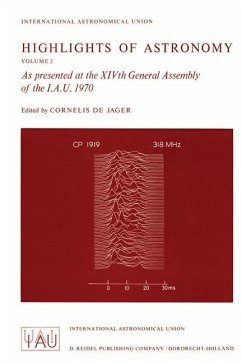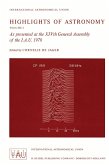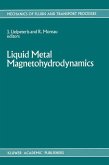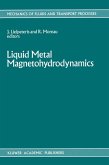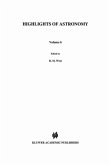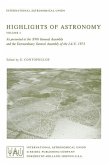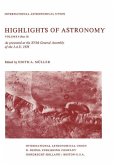Highlights of Astronomy
As presented at the XIVth General Assembly of the I.A.U. 1970
Herausgegeben:Jager, C.
Highlights of Astronomy
As presented at the XIVth General Assembly of the I.A.U. 1970
Herausgegeben:Jager, C.
- Broschiertes Buch
- Merkliste
- Auf die Merkliste
- Bewerten Bewerten
- Teilen
- Produkt teilen
- Produkterinnerung
- Produkterinnerung
After the same pattern as the XIII th General Assembly of the International Astronom ical Union the present Volume of the Highlights in Astronomy contains the texts of the invited discourses given at the XIVth General Assembly held in Brighton, England, August 1970. It contains further the papers and discussion remarks presented at the six joint discussions, as well as the invited papers given at the special session on the Moon. In addition this Volume contains the papers given at the joint meeting of Commissions 24, 27, 30, 33 and 37 on RR Lyrae Stars. It goes without saying that the nearly…mehr
Andere Kunden interessierten sich auch für
![Highlights of Astronomy Highlights of Astronomy]() C.de Jager (ed.)Highlights of Astronomy141,99 €
C.de Jager (ed.)Highlights of Astronomy141,99 €![Highlights of Astronomy Highlights of Astronomy]() Highlights of Astronomy39,99 €
Highlights of Astronomy39,99 €![Highlights of Astronomy Highlights of Astronomy]() L. Perek (ed.)Highlights of Astronomy99,99 €
L. Perek (ed.)Highlights of Astronomy99,99 €![Highlights of Astronomy Highlights of Astronomy]() WestHighlights of Astronomy231,99 €
WestHighlights of Astronomy231,99 €![Highlights of Astronomy Highlights of Astronomy]() Richard M. West (ed.)Highlights of Astronomy229,99 €
Richard M. West (ed.)Highlights of Astronomy229,99 €![Highlights of Astronomy Highlights of Astronomy]() Highlights of Astronomy39,99 €
Highlights of Astronomy39,99 €![Highlights of Astronomy Highlights of Astronomy]() MüllerHighlights of Astronomy115,99 €
MüllerHighlights of Astronomy115,99 €-
-
-
After the same pattern as the XIII th General Assembly of the International Astronom ical Union the present Volume of the Highlights in Astronomy contains the texts of the invited discourses given at the XIVth General Assembly held in Brighton, England, August 1970. It contains further the papers and discussion remarks presented at the six joint discussions, as well as the invited papers given at the special session on the Moon. In addition this Volume contains the papers given at the joint meeting of Commissions 24, 27, 30, 33 and 37 on RR Lyrae Stars. It goes without saying that the nearly hundred papers printed in this Volume represent only a minor part of all matter dealt with at the XIVth General Assembly of the Union; the many important discussions that took place in a few hundred commission meetings are not included. For short abstracts and reviews of these the reader is referred to Transactions of the International Astronomical Union XIVB. I wish to thank those who contributed to this Volume for the speed in submitting the manuscripts of their papers. This, together with the efficiency of the Publishers allowed for a rapid publication.
Hinweis: Dieser Artikel kann nur an eine deutsche Lieferadresse ausgeliefert werden.
Hinweis: Dieser Artikel kann nur an eine deutsche Lieferadresse ausgeliefert werden.
Produktdetails
- Produktdetails
- International Astronomical Union Highlights 2
- Verlag: Springer / Springer Netherlands
- Artikelnr. des Verlages: 978-94-010-3104-2
- Softcover reprint of the original 1st ed. 1971
- Seitenzahl: 808
- Erscheinungstermin: 9. November 2011
- Englisch
- Abmessung: 240mm x 160mm x 44mm
- Gewicht: 1265g
- ISBN-13: 9789401031042
- ISBN-10: 9401031045
- Artikelnr.: 39502432
- Herstellerkennzeichnung
- Springer-Verlag GmbH
- Tiergartenstr. 17
- 69121 Heidelberg
- ProductSafety@springernature.com
- International Astronomical Union Highlights 2
- Verlag: Springer / Springer Netherlands
- Artikelnr. des Verlages: 978-94-010-3104-2
- Softcover reprint of the original 1st ed. 1971
- Seitenzahl: 808
- Erscheinungstermin: 9. November 2011
- Englisch
- Abmessung: 240mm x 160mm x 44mm
- Gewicht: 1265g
- ISBN-13: 9789401031042
- ISBN-10: 9401031045
- Artikelnr.: 39502432
- Herstellerkennzeichnung
- Springer-Verlag GmbH
- Tiergartenstr. 17
- 69121 Heidelberg
- ProductSafety@springernature.com
I. Invited Discourses.- Pulsars.- Pulsars (Theoretical Considerations).- Observational Evidence for Galactic Spiral Structure.- Theory of Spiral Structure.- II. Special Meeting on Direct Exploration of the Moon.- The Apollo Missions.- Lunar Igneous Activity and Differentiation.- Seismology of the Moon and Implications on Internal Structure, Origin and Evolution.- Induced and Permanent Magnetism on the Moon: Structural and Evolutionary Implications.- III. Joint Discussions.- A. The Origin of the Earth and Planets (Edited by B. M. Middlehurst).- Opening Remarks.- I. Origin of the Solar Nebula (inv. speaker: F. Hoyle).- II. Internal Constitution and Thermal Histories of the Terrestrial Planets (inv. speaker: B. Levin).- III. Internal Constitution of the Giant Planets (inv. speaker: W. De Marcus).- IV. Open Discussion.- B. Helium in the Universe (Edited by J. S. Mathis).- Opening Remarks at Joint Discussion on the Helium in the Universe.- Introductory Talk.- Abundance of Helium in Stellar Atmospheres.- The Abundance of Helium in Stellar Interiors.- Abundances of Helium in Gaseous Nebulae.- Production of Helium by Stellar Evolution.- Production of Helium in Massive Objects.- Helium Production in the Different Cosmological Models.- Helium in the Universe: Final Summary.- C. Interstellar Molecules (Edited by D. McNally).- Introductory Remarks.- 1. The Observations.- Interstellar Molecules - the Optical Region.- Infrared Observations and Interstellar Molecules.- Microwave Evidence for Interstellar Molecules.- Molecules in Dense Clouds and Protostars.- OH as a Constituent of the Interstellar Medium.- ? doublet Radiation from OH Excited Rotational States.- Interstellar Formaldehyde.- The Relative Density of H, OH and H2CO in Interstellar Clouds.- NH3 and H2O emission in ourGalaxy.- Radio Emission from Interstellar Hydrogen Cyanide and X-ogen.- 2. Formation of Molecules.- Laboratory Studies of the Spectra of Interstellar Molecules.- Interstellar Molecule Formation; Radiative Association and Exchange Reactions.- Molecule Formation on Grain Surfaces.- Photochemistry of Atoms and Molecules in the Adsorbed State.- Interstellar Molecules from Cool Stars.- 3. Excitation Mechanisms.- Panel Discussion.- Final Remarks.- D. Atomic Data of Importance for Ultraviolet and X-Ray Astronomy (Edited by C. Jordan).- The Interpretation of Space Observations of Stars and Interstellar Matter.- The Interpretation of XUV Solar Radiation.- Some Problems Relating to Solar Line Identification.- Opacity Sources in the UV Spectrum of the Sun.- Atomic Data of Importance for Ultra-violet and X-Ray Astronomy: a Review of Theory.- Computer Programs for Calculating Atomic Data for Ions.- Collision Strengths for Electron Excitation of Coronal Ions.- The Electron Excitation Rate for the Green Coronal Line at 5303 Å.- The Relative Intensities of Lines from Bei-like Ions in the Solar Spectrum.- The Relevance to Astrophysics of the Results of Recent Experiments with Colliding Charged-Particle Beams.- Results Obtained from Observations of Laboratory Plasmas.- Relativistic Contributions to Energies of Highly Ionized Atoms.- Relativistic Corrections to Atomic Energy Levels.- Magnetic Multipole Transition Probabilities.- Pressure Broadening of UV Lines.- New Results on Electron Broadening of some UV Lines of Nii, Cii, Civ and Si ii, Si iii, Si iv.- On the Polarization and Anisotropy of Solar X-Radiation during Flares.- Summary of the Joint Discussion. Atomic Data of Importance for Ultraviolet and X-Ray Astronomy.- E. Photo-Electric Observations of Stellar Occultations (Edited byT. J. Deeming).- The Value of Photoelectric Occultation Timings in Lunar Motion Studies.- A Comparative Study of Visual and Photoelectric Timing of Occultations.- Geodetic Applications of Grazing Occultations.- The Investigation of Lunar Limb Structure by Means of Stellar Occultations.- Optical and Radio Occultation Analysis.- Seeing Effects on Occultation Curves.- A Data Acquisition System with On-line Computer.- Lunar Occultation Theory and Techniques.- Photoelectric Observations of Occultations in Japan.- A Preliminary Analysis of Photoelectric Occultation Measurements.- The Effects of Filters and Colour on Stellar Occultations and Appropriate Deconvolution Procedures.- Remarks on the Restoration of Occultation Observations.- Analysis of Lunar Occultation Data.- Photometric Observations of the Occultations of Stars by the Moon.- Some recent Observations of Occultations by the Moon.- Angular Diameters of the Red Giants 46 Leo and ø Aqr and Parameters of some Binary Systems from Occultation Observations.- Photoelectric Occultation Observations of Regulus and the Pleiades.- Occultation Studies at the Dominion Astrophysical Observatory.- The Determination of Angular Diameters of Stars.- Closing Remarks.- F. Pulsars, Cosmic Rays and Background Radiation (Edited by M. J. Rees).- Some Astrophysical Aspects of Pulsars.- Pulsars and the Origin of Cosmic Rays.- Surface Composition and Cooling Histories of Neutron Stars.- Remarks on the Role of Pulsars in Cosmic Ray Production.- Composition and Galactic Confinement of Cosmic Rays.- The Cosmic Background Radiation: Some Recent Developments.- IV. The Absolute Magnitudes of the RR Lyrae Stars (Joint Meeting of Commissions 24, 27, 30, 33 and 37) (Edited by W. S. Fitch).- The Absolute Magnitudes of the RR Lyrae Stars.- AbsoluteMagnitudes of RR Lyrae Stars.- Review of Observational Data on RR Lyrae Stars.- Absolute Magnitudes of RR Lyrae Variables.- The Lick Observatory Program on Proper Motions of RR Lyrae Stars.- General Discussion.
I. Invited Discourses.- Pulsars.- Pulsars (Theoretical Considerations).- Observational Evidence for Galactic Spiral Structure.- Theory of Spiral Structure.- II. Special Meeting on Direct Exploration of the Moon.- The Apollo Missions.- Lunar Igneous Activity and Differentiation.- Seismology of the Moon and Implications on Internal Structure, Origin and Evolution.- Induced and Permanent Magnetism on the Moon: Structural and Evolutionary Implications.- III. Joint Discussions.- A. The Origin of the Earth and Planets (Edited by B. M. Middlehurst).- Opening Remarks.- I. Origin of the Solar Nebula (inv. speaker: F. Hoyle).- II. Internal Constitution and Thermal Histories of the Terrestrial Planets (inv. speaker: B. Levin).- III. Internal Constitution of the Giant Planets (inv. speaker: W. De Marcus).- IV. Open Discussion.- B. Helium in the Universe (Edited by J. S. Mathis).- Opening Remarks at Joint Discussion on the Helium in the Universe.- Introductory Talk.- Abundance of Helium in Stellar Atmospheres.- The Abundance of Helium in Stellar Interiors.- Abundances of Helium in Gaseous Nebulae.- Production of Helium by Stellar Evolution.- Production of Helium in Massive Objects.- Helium Production in the Different Cosmological Models.- Helium in the Universe: Final Summary.- C. Interstellar Molecules (Edited by D. McNally).- Introductory Remarks.- 1. The Observations.- Interstellar Molecules - the Optical Region.- Infrared Observations and Interstellar Molecules.- Microwave Evidence for Interstellar Molecules.- Molecules in Dense Clouds and Protostars.- OH as a Constituent of the Interstellar Medium.- ? doublet Radiation from OH Excited Rotational States.- Interstellar Formaldehyde.- The Relative Density of H, OH and H2CO in Interstellar Clouds.- NH3 and H2O emission in ourGalaxy.- Radio Emission from Interstellar Hydrogen Cyanide and X-ogen.- 2. Formation of Molecules.- Laboratory Studies of the Spectra of Interstellar Molecules.- Interstellar Molecule Formation; Radiative Association and Exchange Reactions.- Molecule Formation on Grain Surfaces.- Photochemistry of Atoms and Molecules in the Adsorbed State.- Interstellar Molecules from Cool Stars.- 3. Excitation Mechanisms.- Panel Discussion.- Final Remarks.- D. Atomic Data of Importance for Ultraviolet and X-Ray Astronomy (Edited by C. Jordan).- The Interpretation of Space Observations of Stars and Interstellar Matter.- The Interpretation of XUV Solar Radiation.- Some Problems Relating to Solar Line Identification.- Opacity Sources in the UV Spectrum of the Sun.- Atomic Data of Importance for Ultra-violet and X-Ray Astronomy: a Review of Theory.- Computer Programs for Calculating Atomic Data for Ions.- Collision Strengths for Electron Excitation of Coronal Ions.- The Electron Excitation Rate for the Green Coronal Line at 5303 Å.- The Relative Intensities of Lines from Bei-like Ions in the Solar Spectrum.- The Relevance to Astrophysics of the Results of Recent Experiments with Colliding Charged-Particle Beams.- Results Obtained from Observations of Laboratory Plasmas.- Relativistic Contributions to Energies of Highly Ionized Atoms.- Relativistic Corrections to Atomic Energy Levels.- Magnetic Multipole Transition Probabilities.- Pressure Broadening of UV Lines.- New Results on Electron Broadening of some UV Lines of Nii, Cii, Civ and Si ii, Si iii, Si iv.- On the Polarization and Anisotropy of Solar X-Radiation during Flares.- Summary of the Joint Discussion. Atomic Data of Importance for Ultraviolet and X-Ray Astronomy.- E. Photo-Electric Observations of Stellar Occultations (Edited byT. J. Deeming).- The Value of Photoelectric Occultation Timings in Lunar Motion Studies.- A Comparative Study of Visual and Photoelectric Timing of Occultations.- Geodetic Applications of Grazing Occultations.- The Investigation of Lunar Limb Structure by Means of Stellar Occultations.- Optical and Radio Occultation Analysis.- Seeing Effects on Occultation Curves.- A Data Acquisition System with On-line Computer.- Lunar Occultation Theory and Techniques.- Photoelectric Observations of Occultations in Japan.- A Preliminary Analysis of Photoelectric Occultation Measurements.- The Effects of Filters and Colour on Stellar Occultations and Appropriate Deconvolution Procedures.- Remarks on the Restoration of Occultation Observations.- Analysis of Lunar Occultation Data.- Photometric Observations of the Occultations of Stars by the Moon.- Some recent Observations of Occultations by the Moon.- Angular Diameters of the Red Giants 46 Leo and ø Aqr and Parameters of some Binary Systems from Occultation Observations.- Photoelectric Occultation Observations of Regulus and the Pleiades.- Occultation Studies at the Dominion Astrophysical Observatory.- The Determination of Angular Diameters of Stars.- Closing Remarks.- F. Pulsars, Cosmic Rays and Background Radiation (Edited by M. J. Rees).- Some Astrophysical Aspects of Pulsars.- Pulsars and the Origin of Cosmic Rays.- Surface Composition and Cooling Histories of Neutron Stars.- Remarks on the Role of Pulsars in Cosmic Ray Production.- Composition and Galactic Confinement of Cosmic Rays.- The Cosmic Background Radiation: Some Recent Developments.- IV. The Absolute Magnitudes of the RR Lyrae Stars (Joint Meeting of Commissions 24, 27, 30, 33 and 37) (Edited by W. S. Fitch).- The Absolute Magnitudes of the RR Lyrae Stars.- AbsoluteMagnitudes of RR Lyrae Stars.- Review of Observational Data on RR Lyrae Stars.- Absolute Magnitudes of RR Lyrae Variables.- The Lick Observatory Program on Proper Motions of RR Lyrae Stars.- General Discussion.

